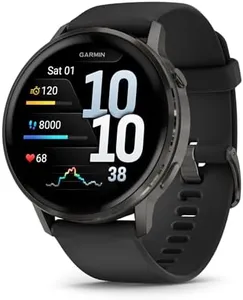10 Best Fitness Trackers 2026 in the United States
Our technology thoroughly searches through the online shopping world, reviewing hundreds of sites. We then process and analyze this information, updating in real-time to bring you the latest top-rated products. This way, you always get the best and most current options available.

Our Top Picks
Winner
Apple Watch Series 11 [GPS 46mm] Smartwatch with Space Gray Aluminum Case with Black Sport Band - M/L. Sleep Score, Fitness Tracker, Health Monitoring, Always-On Display, Water Resistant
Most important from
1859 reviews
The Apple Watch Series 11 GPS 46mm is a strong choice if you want a fitness tracker that goes beyond basic activity monitoring. It offers comprehensive health tracking, including detailed heart rate monitoring, ECG readings, blood oxygen levels, and even hypertension and sleep apnea notifications, which is quite advanced. The sleep tracking with a sleep score helps you understand and improve your rest. Its built-in GPS ensures accurate workout and location tracking, ideal for running or outdoor exercise. The watch is water resistant up to 50 meters and dust resistant, making it durable enough for swimming and everyday wear. The always-on, bright Retina OLED display is easy to read during workouts or day-to-day use.
Battery life delivers about 24 hours under typical use, covering a full day but meaning you’ll likely need to charge it nightly; however, fast charging helps if you’re in a hurry. Compatibility is designed primarily for iPhone users, so it works best if you already have an iPhone. The lightweight, thin design makes it comfortable to wear all day, including while sleeping for continuous tracking. Safety features like fall and crash detection add extra peace of mind.
This smartwatch suits those who want an extensive health and fitness tool combined with smart features and are invested in the Apple ecosystem. While battery life might be a limitation if you prefer longer use without daily charging, and the price point tends to be higher than simpler fitness bands, it offers significant value for users seeking advanced monitoring and seamless integration.
Most important from
1859 reviews
Fitbit Charge 6 Fitness Tracker with Google apps, Heart Rate on Exercise Equipment, 6-Months Premium Membership Included, GPS, Health Tools and More, Obsidian/Black, One Size (S & L Bands Included)
Most important from
18492 reviews
The Fitbit Charge 6 is a robust fitness tracker that excels in providing comprehensive activity monitoring and health insights. With features like 40+ exercise modes, built-in GPS, and 24/7 heart rate monitoring, it effectively caters to fitness enthusiasts looking to track their workouts and health metrics in real-time. The addition of a 6-month premium membership offers users valuable access to advanced health tools, including stress management and sleep tracking, which can help users optimize their daily routines. Its water resistance makes it suitable for various environments, whether you’re swimming or sweating it out in the gym.
The Fitbit Charge 6 may not suit everyone’s needs. The small display, while functional at 1.04 inches, could be challenging for users who prefer larger screens for easier navigation. Additionally, while it syncs well with both iOS and Android devices, compatibility with other devices, such as the Google Pixel Buds Pro 2, is limited, which might disappoint some users seeking more seamless integration. Battery life is decent but may require regular charging, especially with extensive use of GPS and other features.
Most important from
18492 reviews
WHOOP Life – 12-Month Membership – MG Device – Health & Fitness Tracker – Blood Pressure Insights, Activity Tracking – ECG Software – 14+ Days Battery Life
Most important from
1862 reviews
The WHOOP Life fitness tracker offers a comprehensive health and fitness monitoring experience, especially for those serious about detailed insights. It continuously tracks activity, heart rate, sleep, and stress, giving you a well-rounded view of your health. Unique features include on-demand ECG readings to detect heart irregularities and innovative blood pressure monitoring, which many fitness trackers don’t provide. The device is lightweight and waterproof, making it suitable for multi-sport use and daily wear. Battery life lasts up to 14 days, reducing the hassle of frequent charging. Compatibility with smartphones and tablets is broad, allowing easy syncing of your health data.
The WHOOP Life does not offer built-in GPS, so it won’t record routes or distances independently, which may be a limitation for runners or cyclists who want detailed mapping. Additionally, there is no traditional display on the device itself; all feedback and insights are accessed via the companion app, which may reduce convenience for quick checks during workouts. The tracker excels in health metrics and recovery tracking, but lacks features like GPS tracking and an on-device screen.
WHOOP’s membership model requires an annual payment for full service access, which may influence some users' decisions. The WHOOP Life is designed for users focused on deep health insights, long battery life, and recovery optimization.
Most important from
1862 reviews
Buying Guide for the Best Fitness Trackers
Choosing the right fitness tracker can significantly enhance your health and fitness journey. Fitness trackers come with a variety of features that can help you monitor your activity levels, sleep patterns, heart rate, and more. To find the best fit for you, it's important to understand the key specifications and how they align with your personal fitness goals and lifestyle. Here are some essential specs to consider when selecting a fitness tracker.FAQ
Most Popular Categories Right Now




















